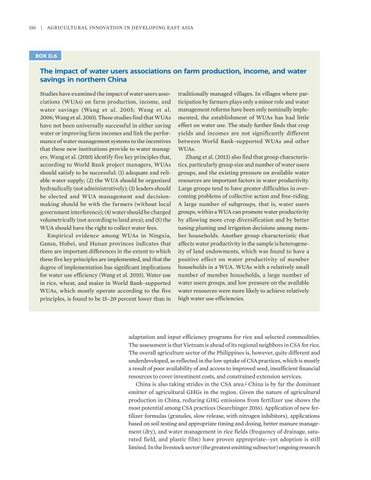156 | Agricultural Innovation in Developing East Asia
BOX D.6
The impact of water users associations on farm production, income, and water savings in northern China Studies have examined the impact of water users associations (WUAs) on farm production, income, and water savings (Wang et al. 2005; Wang et al. 2006; Wang et al. 2010). These studies find that WUAs have not been universally successful in either saving water or improving farm incomes and link the performance of water management systems to the incentives that these new institutions provide to water managers. Wang et al. (2010) identify five key principles that, according to World Bank project managers, WUAs should satisfy to be successful: (1) adequate and reliable water supply; (2) the WUA should be organized hydraulically (not administratively); (3) leaders should be elected and WUA management and decision- making should be with the farmers (without local government interference); (4) water should be charged volumetrically (not according to land area); and (5) the WUA should have the right to collect water fees. Empirical evidence among WUAs in Ningxia, Gansu, Hubei, and Hunan provinces indicates that there are important differences in the extent to which these five key principles are implemented, and that the degree of implementation has significant implications for water use efficiency (Wang et al. 2010). Water use in rice, wheat, and maize in World Bank–supported WUAs, which mostly operate according to the five principles, is found to be 15–20 percent lower than in
traditionally managed villages. In villages where participation by farmers plays only a minor role and water management reforms have been only nominally implemented, the establishment of WUAs has had little effect on water use. The study further finds that crop yields and incomes are not significantly different between World Bank–supported WUAs and other WUAs. Zhang et al. (2013) also find that group characteristics, particularly group size and number of water users groups, and the existing pressure on available water resources are important factors in water productivity. Large groups tend to have greater difficulties in overcoming problems of collective action and free-riding. A large number of subgroups, that is, water users groups, within a WUA can promote water productivity by allowing more crop diversification and by better tuning planting and irrigation decisions among member households. Another group characteristic that affects water productivity in the sample is heterogeneity of land endowments, which was found to have a positive effect on water productivity of member households in a WUA. WUAs with a relatively small number of member households, a large number of water users groups, and low pressure on the available water resources were more likely to achieve relatively high water use efficiencies.
adaptation and input efficiency programs for rice and selected commodities. The assessment is that Vietnam is ahead of its regional neighbors in CSA for rice. The overall agriculture sector of the Philippines is, however, quite different and underdeveloped, as reflected in the low uptake of CSA practices, which is mostly a result of poor availability of and access to improved seed, insufficient financial resources to cover investment costs, and constrained extension services. China is also taking strides in the CSA area.2 China is by far the dominant emitter of agricultural GHGs in the region. Given the nature of agricultural production in China, reducing GHG emissions from fertilizer use shows the most potential among CSA practices (Searchinger 2016). Application of new fertilizer formulas (granules, slow release, with nitrogen inhibitors), applications based on soil testing and appropriate timing and dosing, better manure management (dry), and water management in rice fields (frequency of drainage, saturated field, and plastic film) have proven appropriate—yet adoption is still limited. In the livestock sector (the greatest emitting subsector) ongoing research

